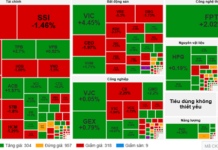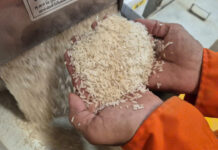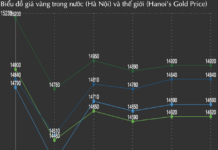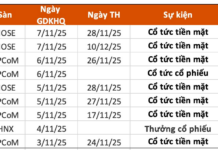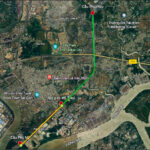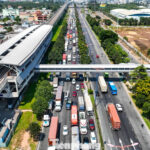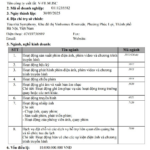At the Ho Chi Minh City People’s Committee meeting on the socio-economic situation in the first 10 months of 2025, Director of the Department of Construction Tran Quang Lam announced that the city will simultaneously commence four BOT gateway transportation projects in mid-2026. These projects include the upgrading and expansion of National Highway 1, National Highway 13, National Highway 22, and the North-South Axis—all vital arteries aimed at reducing congestion and enhancing connectivity between Ho Chi Minh City and the Southeast and Southwest regions.
Currently, the Department of Construction is conducting environmental impact assessments for all four projects and organizing architectural design competitions for National Highway 1 and the North-South Axis. Relevant units are collaborating to finalize investment dossiers for these projects.
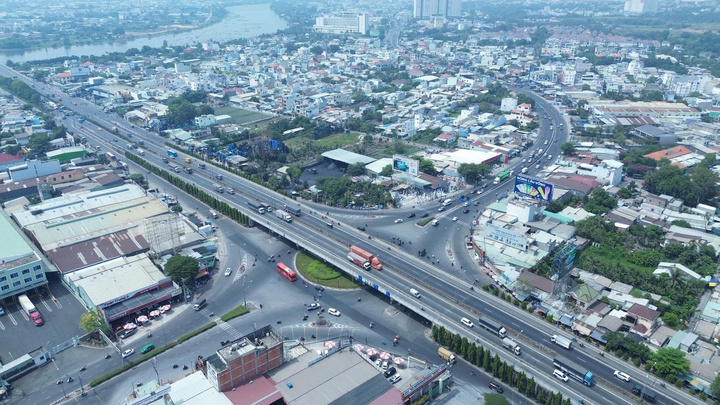
Four gateway transportation projects in Ho Chi Minh City will commence simultaneously in Q2/2026. (Photo: Anh Khoa)
With a total investment of nearly VND 60 trillion, these four gateway transportation projects, implemented under the BOT model, were approved by the Ho Chi Minh City People’s Council in February under the special mechanism of Resolution 98. The Department of Construction is working with Project Management Units to expedite compensation approval, resettlement, and public investment disbursement. Land clearance costs alone are estimated at VND 27 trillion.
Specifically, the National Highway 13 upgrade and expansion project has disbursed approximately VND 12,435 billion. The Department of Construction has completed the selection of consulting contractors for surveys and feasibility studies, with plans to submit them for appraisal and approval in Q4/2025, ensuring a mid-2026 groundbreaking.
National Highway 13 BOT Upgrade and Expansion Project

National Highway 13, a major gateway in the northeast of Ho Chi Minh City, frequently suffers from congestion and flooding during rain and high tides. (Photo: Anh Khoa)
The National Highway 13 upgrade and expansion project, spanning nearly 6 km from Binh Trieu Bridge to Vinh Binh Bridge, will be widened to approximately 60 meters with 10 lanes. Over 3.2 km will feature an elevated road with 4 lanes designed for speeds up to 80 km/h.
The project also includes two two-way underpasses at Binh Loi and Binh Phuoc intersections to separate traffic flows, reduce conflicts, and enhance overall traffic capacity.
With a total investment of approximately VND 21 trillion, the project is expected to be completed by 2028, with a fee collection period of around 21 years.

Rendering of National Highway 13 combining an elevated road and parallel lanes. (Source: Department of Construction)
National Highway 13, stretching over 140 km, connects Ho Chi Minh City with Binh Duong and Binh Phuoc (now part of Dong Nai). As a major gateway in the city’s northeast, it often experiences severe congestion and flooding during rain and high tides.
National Highway 1 BOT Upgrade and Expansion Project
The National Highway 1 upgrade and expansion project, from Kinh Duong Vuong Street to the border with Long An (now part of Tay Ninh), spans nearly 10 km and will be widened to 60 meters with 10–12 lanes. Six to eight main lanes will accommodate fast traffic at 80 km/h, while two parallel lanes on either side will serve motorcycles and mixed vehicles at 60 km/h.
The project includes the construction of four multi-level intersections and the renovation of critical infrastructure.

National Highway 1, from Kinh Duong Vuong Street to the former Long An border (now Tay Ninh), is a congestion hotspot in the city’s western gateway. (Photo: Anh Khoa)
Key structures such as Binh Dien Bridge and major intersections like Kinh Duong Vuong, Binh Thuan, and Doan Nguyen Tuan will be expanded. Binh Dien Bridge will add a new 6-lane unit on the right, widening it to 28.5 meters. Currently, the bridge has two units with a total of 6 lanes.
At the Binh Thuan intersection (connecting National Highway 1, Nguyen Van Linh Avenue, and the Ho Chi Minh City – Trung Luong Expressway), a three-level system will be built, including two 4-lane underpasses. The ground level will feature a central roundabout, with an overpass system above. Two pedestrian bridges will also be constructed along the expressway and Nguyen Van Linh Avenue.
The An Lac intersection will feature a 4-lane overpass connecting National Highway 1, Kinh Duong Vuong, and Tran Dai Nghia streets, allowing direct traffic flow through the main axis and reducing conflicts.
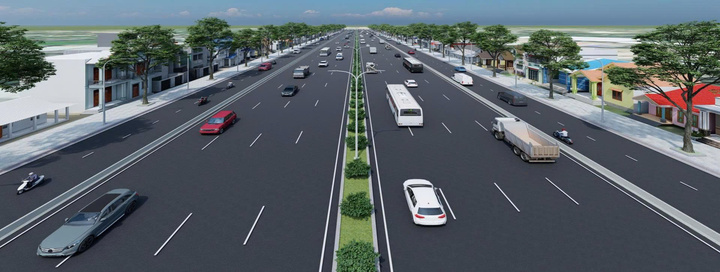
Rendering of the upgraded and expanded road. (Source: Department of Construction)
With a total investment exceeding VND 16,285 billion, the project is expected to be operational by 2028, with a fee collection period of approximately 21 years and 10 months. To minimize impact on local residents, fees will only be collected on the main fast-traffic lanes.
Recently, the Ho Chi Minh City People’s Committee approved two sub-projects related to compensation, support, and resettlement. The project affects 2,241 households, with 1,822 requiring complete relocation.
National Highway 1, from Kinh Duong Vuong Street to the former Long An border, is a vital artery connecting Ho Chi Minh City with the Southwest region and the city’s Ring Roads 2, 3, and 4.
North-South Axis Upgrade Project
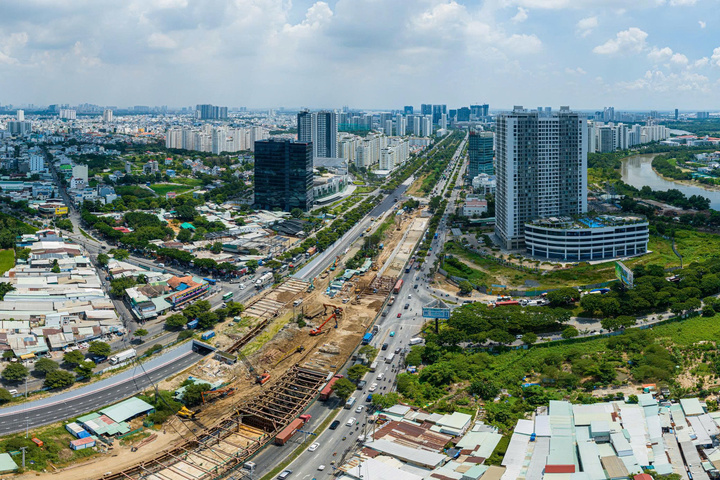
The North-South Axis from Nguyen Van Linh to the Ben Luc – Long Thanh Expressway will be expanded to 10 lanes, including 7.2 km of elevated road. (Photo: Anh Khoa)
The North-South Axis upgrade project, stretching 8.6 km from Nguyen Van Linh to the Ben Luc – Long Thanh Expressway, will be widened to 10 lanes. This includes 7.2 km of elevated road with 4 lanes designed for speeds up to 80 km/h, and parallel ground-level roads with 3 lanes on each side, allowing speeds up to 60 km/h. The project will also feature 14 bridges along both sides.
The main elevated section will be slightly offset to the left of the planned alignment to avoid existing water pipelines and accommodate the future Metro Line 4.
Multi-level intersections will be constructed at Nguyen Van Linh and the Ben Luc – Long Thanh Expressway, prioritizing uninterrupted traffic flow for vehicles traveling between Nguyen Huu Tho, Nguyen Van Linh, and the expressway.
With a total investment of VND 9,894 billion, the project is expected to be completed by 2028, with a fee collection period of approximately 22 years.

Design rendering of the North-South Axis featuring 7.2 km of elevated road with 4 lanes at 80 km/h and parallel ground-level roads with 3 lanes on each side. (Source: Department of Construction)
Upon completion, the road is expected to become a fast, uninterrupted transportation axis connecting the city center with the new South Saigon urban area, the Hiep Phuoc port-urban area, and forming a radial transportation axis linking Ring Road 2 with the Ben Luc – Long Thanh Expressway and Ring Road 4. This will meet inter-regional traffic demands in the southern gateway of Ho Chi Minh City, connecting the Southeast and Southwest regions.
In early September, the Ho Chi Minh City People’s Committee approved the architectural design competition plan for the main elevated bridge on the North-South Axis, from Nguyen Van Linh to the Ben Luc – Long Thanh Expressway.
National Highway 22 Upgrade and Renovation Project
National Highway 22, a vital artery connecting Ho Chi Minh City with the Moc Bai International Border Gate (Tay Ninh), will undergo an 8 km upgrade from the An Suong intersection to Ho Chi Minh City’s Ring Road 3, with a total investment of VND 10,424 billion.
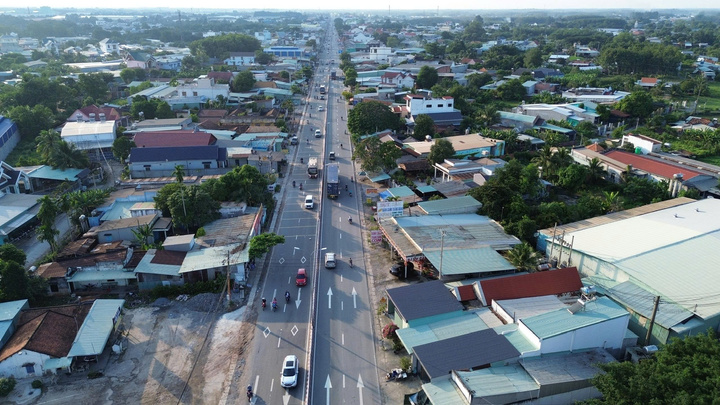
The National Highway 22 upgrade and renovation project, spanning 8 km from the An Suong intersection to Ring Road 3, with a total investment of VND 10,424 billion, will also commence in Q2/2026. (Photo: Anh Khoa)
Post-upgrade, National Highway 22 will be widened to 60 meters with 10 lanes: 4 central lanes for vehicles at up to 80 km/h and 6 parallel lanes at 60 km/h, effectively separating traffic flows and enhancing safety.
The project will also construct 7 overpasses at key intersections, creating a seamless traffic network that minimizes conflicts and prolonged congestion.
Expected to be completed and operational by 2028, the project will have a fee collection period of approximately 23 years and 10 months. Fees will only apply to the central high-speed lanes for vehicles.
The Department of Construction has also led, prepared, and submitted for approval 9 key Group A projects, including Ho Chi Minh City’s Ring Road 4—a nationally significant project—the Binh Tien Bridge and Road, the Ha Noi Highway connector to the Go Cong intersection, the expansion of Nguyen Duy Trinh Road, and the construction of the Thoi An – Thanh Xuan Road.
In December, dossiers for three key projects will be submitted for appraisal: the Can Gio Bridge, Thu Thiem 4 Bridge, and the Cat Lai – Phu Huu Port Road.
The Department is also surveying and preparing pre-feasibility studies for 14 critical transportation projects, including Ring Road 2 (Section 4), the expansion of Truong Chinh – Cong Hoa Road, Xô Viet Nghe Tinh Road, Le Van Luong Road, and the East-West Avenue (from National Highway 1 to Long An, now Tay Ninh)…
Vietnam Pioneers as the World’s First Nation to Achieve This Ambitious Goal
Prime Minister mandates the immediate operational launch of Vietnam’s International Financial Center by November.
Strategic Placement of 8 Elevators Across 7 Pedestrian Overpasses at Metro Station No. 1
To enhance accessibility and convenience for residents, the Ho Chi Minh City Department of Construction has approved a project to construct and install elevators at pedestrian overpasses connected to elevated stations on Metro Line No. 1 (Bến Thành – Suối Tiên). The initiative, funded by the city’s budget, boasts a total investment of over 53.4 billion VND.
Vietnam’s International Financial Center Set to Launch Operations This Month
The Prime Minister emphasized this directive while concluding the Conference on the Establishment of an International Financial Center in Vietnam, held on the morning of November 1st. The conference was conducted via teleconference, connecting participants from the UK, the Czech Republic, Hong Kong (China), and Indonesia.

